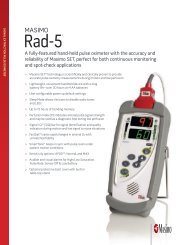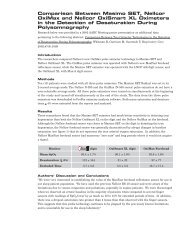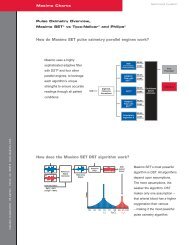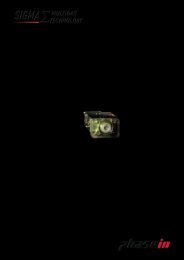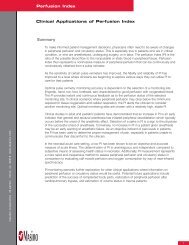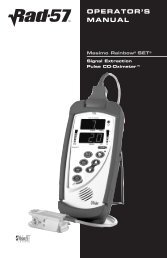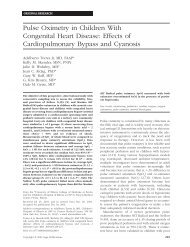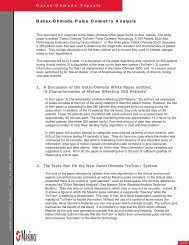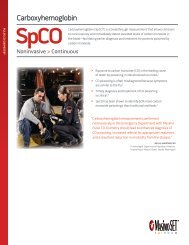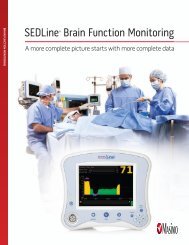Anesthesia Gas Monitoring: Evolution of a de facto ... - Masimo
Anesthesia Gas Monitoring: Evolution of a de facto ... - Masimo
Anesthesia Gas Monitoring: Evolution of a de facto ... - Masimo
You also want an ePaper? Increase the reach of your titles
YUMPU automatically turns print PDFs into web optimized ePapers that Google loves.
Stand-alone mass spectrometers, like the Ohmeda 6000,mitigated that risk and provi<strong>de</strong>d continuous, nearly instantaneous,readings instead <strong>of</strong> intermittent readings <strong>of</strong> a fewseconds (2 breaths analyzed or for 30 seconds if Stat buttonpressed) at a time obtained from a central system. Furthermore,the Ohmeda 6000 was found to be as accurateas a centralized/multiplexed mass spectrometer. 15 In addition,its adjustable flow rate <strong>of</strong> as little as 30 mL/min facilitatedits use with infants. Another advantage <strong>of</strong> the Ohmeda6000 was that it could be s<strong>of</strong>tware programmed to beused with any gas or new agent. 16The 1990s saw the emergence <strong>of</strong> a number <strong>of</strong> competing,more affordable, si<strong>de</strong>stream gas monitoring technologies,which further promoted the use <strong>of</strong> stand-alone anestheticmulti-gas monitoring in each operating room. These technologiesinclu<strong>de</strong> infrared spectrometry, RAMAN spectrometry,infrared photoacoustic spectrometry, and piezoelectriccrystal agent analysis. Agent i<strong>de</strong>ntification, eithersingly or in a mixture, a significant technological advance,was also introduced into the market by a number <strong>of</strong> manufacturers.The importance <strong>of</strong> agent specificity, or i<strong>de</strong>ntification,becomes apparent in cases where vaporizers mayhave inadvertently been misfiled, thereby creating agentmixtures. This may lead to anesthetic overdose not <strong>de</strong>tectableby agent analyzers lacking an agent i<strong>de</strong>ntificationfunction. One such example was the case where is<strong>of</strong>luranewas mistakenly ad<strong>de</strong>d to a halothane vaporizer,causing the agent analyzer to behave erratically and creatingthe initial incorrect impression that it was malfunctioning.17, 18In contemporary anesthesia practice, however, anestheticagents are routinely and intentionally exchanged in midcase.Frequently, induction is started with a rapidly acting(insoluble) agent such as <strong>de</strong>sflurane or sev<strong>of</strong>lurane; theagent is then replaced for maintenance with a less expensiveagent such as is<strong>of</strong>lurane. The safe practice <strong>of</strong> thistechnique provi<strong>de</strong>s additional rationale for the use <strong>of</strong> anesthesiagas analyzers that provi<strong>de</strong> agent i<strong>de</strong>ntification.For a variety <strong>of</strong> technical and commercial reasons, anesthesiagas analyzers based on innovative technologiessuch as Raman spectroscopy, infrared photoacousticspectrometry, and piezoelectric crystal agent analysishave not succee<strong>de</strong>d in the marketplace. Raman scattering<strong>of</strong> laser light was used to i<strong>de</strong>ntify and quantify oxygen,nitrogen, carbon dioxi<strong>de</strong>, nitrous oxi<strong>de</strong> and the potent volatileanesthetic agents. Briefly, when monochromatic lightstrikes gas molecules, most <strong>of</strong> the energy scattered isabsorbed and re‐emitted at a shifted longer wavelengthbased on the constituents gases in a mixture. 19 The measuredshifted wave spectrum, using photomultiplier tubes,quantifies and i<strong>de</strong>ntifies the gases in the mixture. Ramanspectroscopy provi<strong>de</strong>s functionality equivalent to massspectroscopy but at a much lower cost. The best knownproduct based on the Raman scattering principle was theOhmeda RASCAL II, which is no longer on the marketalthough some are still in clinical use.Infrared photoacoustic spectrometry and piezoelectriccrystal agent analysis were technically innovative but sufferedfrom certain limitations which en<strong>de</strong>d their commercialviability. The infrared photoacoustic gas bench wasmarketed as the Brüel & Kjaer 1300. Two piezoelectricbenches were introduced into the market place. The first,the Siemens GM 120 monitor, shown in Figure 4, and thesecond, <strong>de</strong>veloped by ICOR <strong>of</strong> Swe<strong>de</strong>n, was marketed inthe United States by BCI and Vital Signs Inc. Neither theinfrared photoacoustic nor the piezoelectric <strong>de</strong>vices wereagent-specific. 20 In addition, the photoacoustic <strong>de</strong>vice wassensitive to external noise and vibration, 21 and the piezoelectrictechnology exhibited a pronounced sensitivity towater vapor. 22Figure 4: Siemens Servo <strong>Gas</strong> Monitor 120Of the various competing anesthetic gas measurementtechnologies, the infrared photospectrometer, emerges asa commercial and, for the most part, technical success.There are two main reasons for this. The first is that thetechnology could be implemented at a lower cost, thusreaching a larger customer base, and second is that agenti<strong>de</strong>ntification functionality could be readily ad<strong>de</strong>d to theseanalyzers. The number <strong>of</strong> competing infrared-based productson the market since the mid 1980s has greatly proliferated,but many are no longer being marketed due toobsolescence or commercial failure.Infrared-based gas analysis products such the Puritan-Bennett/Datex 222 Anesthetic Agent Monitor, Figure 5,came on the market circa 1984. The Datex 222 was thecompany’s first generation (non-ID) infrared gas bench(Jan Ekström: personal communications). The 222 wassoon followed by the Datex Normac, Dräger’s IRINA,Andros 4600 (analyzer bench)/4700 (agent ID bench),Datex Capnomac, Nellcor 2500, Ohmeda RGM, and Criticare’sPOET II. 23Figure 5: Puritan-Bennett/Datex <strong>Anesthesia</strong> Agent Monitor 2223




